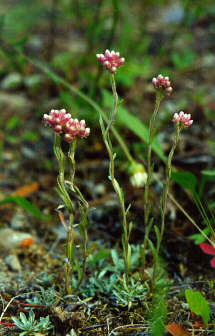Littleleaf pussytoes facts for kids
Quick facts for kids Littleleaf pussytoes |
|
|---|---|
 |
|
| Scientific classification | |
| Genus: |
Antennaria
|
| Species: |
microphylla
|
| Synonyms | |
|
Synonymy
Antennaria bracteosa Rydb.
Antennaria nitida Greene Antennaria angustata Greene Antennaria burwellensis Malte Antennaria congesta Malte Antennaria fernaldiana Polunin Antennaria hudsonica Malte Antennaria megacephala Fernald Antennaria pygmaea Fernald Antennaria solstitialis Lunell ex Lunell Antennaria tansleyi Polunin Antennaria tweedsmuirii Polunin |
|
Antennaria microphylla, also known as littleleaf pussytoes or rosy pussytoes, is a small plant that lives for many years. It spreads using special runners, like a strawberry plant. This plant is a type of forb, which means it's a non-woody plant that isn't a grass. It belongs to the aster family.
You can find littleleaf pussytoes all over northern and western North America. It grows from Alaska and the Canadian Arctic down to states like Minnesota, New Mexico, and California.
What it Looks Like
Littleleaf pussytoes is a small plant, usually growing from about 3 to 30 centimeters (1.2 to 12 inches) tall. It has leaves that are shaped like spoons or are long and oval.
Where it Grows
This plant likes to grow in open, dry places. You can often spot it in plains, on hills, in dry meadows, or in sunny spots in open woods. It's quite tough and can grow in many different environments.
How it Grows
Littleleaf pussytoes has an interesting way of reproducing. Unlike many plants, it has separate male and female plants. This means one plant will have only male flowers, and another plant will have only female flowers.
When it Blooms
The flowers of the littleleaf pussytoes usually appear from late May to July. This is when the plant is in full bloom, showing off its small, often pinkish flowers.
Animal Friends
The littleleaf pussytoes is an important part of its ecosystem. For example, the Columbian ground squirrel enjoys eating this plant. It provides food for these small animals in their natural habitat.

